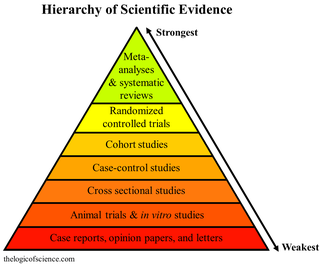
Research is "creative and systematic work undertaken to increase the stock of knowledge". It involves the collection, organization and analysis of evidence to increase understanding of a topic, characterized by a particular attentiveness to controlling sources of bias and error. These activities are characterized by accounting and controlling for biases. A research project may be an expansion of past work in the field. To test the validity of instruments, procedures, or experiments, research may replicate elements of prior projects or the project as a whole.

Meta-analysis is the statistical combination of the results of multiple studies addressing a similar research question. An important part of this method involves computing an effect size across all of the studies, this involves extracting effect sizes and variance measures from various studies. Meta-analyses are integral in supporting research grant proposals, shaping treatment guidelines, and influencing health policies. They are also pivotal in summarizing existing research to guide future studies, thereby cementing their role as a fundamental methodology in metascience. Meta-analyses are often, but not always, important components of a systematic review procedure. For instance, a meta-analysis may be conducted on several clinical trials of a medical treatment, in an effort to obtain a better understanding of how well the treatment works.

In the study of history as an academic discipline, a primary source is an artifact, document, diary, manuscript, autobiography, recording, or any other source of information that was created at the time under study. It serves as an original source of information about the topic. Similar definitions can be used in library science and other areas of scholarship, although different fields have somewhat different definitions.
Marketing research is the systematic gathering, recording, and analysis of qualitative and quantitative data about issues relating to marketing products and services. The goal is to identify and assess how changing elements of the marketing mix impacts customer behavior.
Qualitative marketing research involves a natural or observational examination of the philosophies that govern consumer behavior. The direction and framework of the research is often revised as new information is gained, allowing the researcher to evaluate issues and subjects in an in-depth manner. The quality of the research produced is heavily dependent on the skills of the researcher and is influenced by researcher bias.
A tertiary source is an index or textual consolidation of already published primary and secondary sources that does not provide additional interpretations or analysis of the sources. Some tertiary sources can be used as an aid to find key (seminal) sources, key terms, general common knowledge and established mainstream science on a topic. The exact definition of tertiary varies by academic field.

A systematic review is a scholarly synthesis of the evidence on a clearly presented topic using critical methods to identify, define and assess research on the topic. A systematic review extracts and interprets data from published studies on the topic, then analyzes, describes, critically appraises and summarizes interpretations into a refined evidence-based conclusion. For example, a systematic review of randomized controlled trials is a way of summarizing and implementing evidence-based medicine.
A source text is a text from which information or ideas are derived. In translation, a source text is the original text that is to be translated into another language.

Aggregate data is high-level data which is acquired by combining individual-level data. For instance, the output of an industry is an aggregate of the firms’ individual outputs within that industry. Aggregate data are applied in statistics, data warehouses, and in economics.
Scholarly communication involves the creation, publication, dissemination and discovery of academic research, primarily in peer-reviewed journals and books. It is “the system through which research and other scholarly writings are created, evaluated for quality, disseminated to the scholarly community, and preserved for future use." This primarily involves the publication of peer-reviewed academic journals, books and conference papers.
Secondary data refers to data that is collected by someone other than the primary user. Common sources of secondary data for social science include censuses, information collected by government departments, organizational records and data that was originally collected for other research purposes. Primary data, by contrast, are collected by the investigator conducting the research.

A review article is an article that summarizes the current state of understanding on a topic within a certain discipline. A review article is generally considered a secondary source since it may analyze and discuss the method and conclusions in previously published studies. It resembles a survey article or, in news publishing, overview article, which also surveys and summarizes previously published primary and secondary sources, instead of reporting new facts and results. Survey articles are however considered tertiary sources, since they do not provide additional analysis and synthesis of new conclusions. A review of such sources is often referred to as a tertiary review.
The marketing research process is a six-step process involving the definition of the problem being studied upon, determining what approach to take, formulation of research design, field work entailed, data preparation and analysis, and the generation of reports, how to present these reports, and overall, how the task can be accomplished.

In common usage data is a collection of discrete or continuous values that convey information, describing the quantity, quality, fact, statistics, other basic units of meaning, or simply sequences of symbols that may be further interpreted formally. A datum is an individual value in a collection of data. Data is usually organized into structures such as tables that provide additional context and meaning, and which may themselves be used as data in larger structures. Data may be used as variables in a computational process. Data may represent abstract ideas or concrete measurements. Data is commonly used in scientific research, economics, and in virtually every other form of human organizational activity. Examples of data sets include price indices, unemployment rates, literacy rates, and census data. In this context, data represents the raw facts and figures from which useful information can be extracted.
A marketing information system (MIS) is a management information system (MIS) designed to support marketing decision making. Jobber (2007) defines it as a "system in which marketing data is formally gathered, stored, analysed and distributed to managers in accordance with their informational needs on a regular basis." In addition, the online business dictionary defines Marketing Information System (MKIS) as "a system that analyzes and assesses marketing information, gathered continuously from sources inside and outside an organization or a store." Furthermore, "an overall Marketing Information System can be defined as a set structure of procedures and methods for the regular, planned collection, analysis and presentation of information for use in making marketing decisions."

In scholarship, a secondary source is a document or recording that relates or discusses information originally presented elsewhere. A secondary source contrasts with a primary source, which is an original source of the information being discussed; a primary source can be a person with direct knowledge of a situation or a document created by such a person.

The University of Michigan Institute for Social Research (ISR) is the largest academic social research and survey organization in the world, established in 1949. ISR includes more than 300 scientists from a variety of academic disciplines – including political science, psychology, sociology, economics, demography, history, anthropology, and statistics. The institute is a unit that houses five separate but interdependent centers which conduct research and maintain data archives. In 2021, Kathleen Cagney became the first woman in its history to be named Director of the institute.
Historical source is an original source that contains important historical information. These sources are something that inform us about history at the most basic level, and are used as clues in order to study history.
Source bias is the tendency to select information sources to support a confirmation bias or negativity bias on a particular set of beliefs or values. Source bias plays an important role in generating echo chambers. In news reporting, source bias effects how news organizations do news gathering in whom they choose to talk, and in news analysis, what they imply in the way they arrange facts collected.







